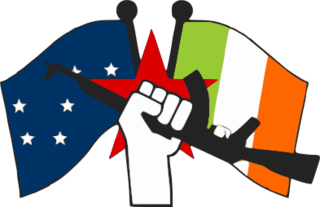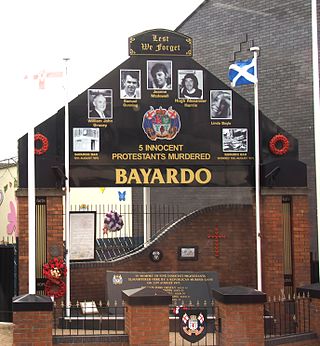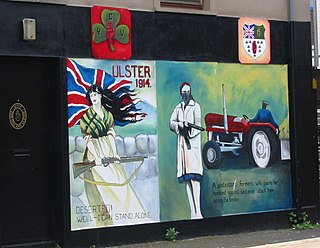This article has multiple issues. Please help improve it or discuss these issues on the talk page . (Learn how and when to remove these messages)
|
The following is a timeline of events pertaining to the Troubles in Dublin, Republic of Ireland.
This article has multiple issues. Please help improve it or discuss these issues on the talk page . (Learn how and when to remove these messages)
|
The following is a timeline of events pertaining to the Troubles in Dublin, Republic of Ireland.

The Irish National Liberation Army is an Irish republican socialist paramilitary group formed on 8 December 1974, during the 30-year period of conflict known as "the Troubles". The group seeks to remove Northern Ireland from the United Kingdom and create a socialist republic encompassing all of Ireland. With membership estimated at 80–100 at their peak, it is the paramilitary wing of the Irish Republican Socialist Party (IRSP).

The Loyalist Volunteer Force (LVF) was an Ulster loyalist paramilitary group in Northern Ireland. It was formed by Billy Wright in 1996 when he and his unit split from the Ulster Volunteer Force (UVF) after breaking its ceasefire. Most of its members came from the UVF's Mid-Ulster Brigade, which Wright had commanded. In a two-year period from August 1996, the LVF waged a paramilitary campaign in opposition to Irish republicanism and the Northern Ireland peace process. During this time it killed at least 14 people in gun and bomb attacks, almost all of them Catholic civilians killed at random. The LVF called off its campaign in August 1998 and decommissioned some of its weapons, but in the early 2000s a loyalist feud led to several killings. Since then, the LVF has been largely inactive, but its members are believed to have been involved in rioting and organized crime. In 2015, the security forces stated that the LVF "exists only as a criminal group" in Mid-Ulster and Antrim.

The Irish People's Liberation Organisation was a small Irish socialist republican paramilitary organisation formed in 1986 by disaffected and expelled members of the Irish National Liberation Army (INLA), whose factions coalesced in the aftermath of the supergrass trials. It developed a reputation for intra-republican and sectarian violence as well as criminality, before being forcibly disbanded by the Provisional Irish Republican Army (IRA) in 1992.
Hugh Torney was an Irish National Liberation Army (INLA) paramilitary leader best known for his activities on behalf of the INLA and Irish Republican Socialist Party (IRSP) in a feud with the Irish People's Liberation Organisation (IPLO), a grouping composed of disgruntled former INLA members, in the mid-1980s; and later an internal feud following his expulsion from the organisation and eventual death.

This article recounts the violence and other effects related to The Troubles in Portadown, County Armagh, Northern Ireland. Much of it has been related to the Drumcree parade dispute.
The Troubles in Armagh recounts incidents during The Troubles in Armagh City, County Armagh, Northern Ireland; the violence was substantial enough for a stretch of road on the outskirts of the city to be referred to by one RUC officer as "Murder Mile". Over the course of the Troubles, although mainly concentrated in the years from 1969 until 1994, the small city of around 15,000 people, including some outlying areas, saw 86 deaths, including those of a number of people from the city who lost their lives elsewhere in Troubles-related incidents.

Saor Éire, also known as the Saor Éire Action Group, was an armed Irish republican organisation composed of Trotskyists and ex-IRA members. It took its name from a similar organisation of the 1930s.

Martin "Doco" Doherty was a volunteer in the Provisional Irish Republican Army (IRA), who was shot dead while attempting to prevent a bombing by the Ulster Volunteer Force (UVF) at a pub in Dublin, Republic of Ireland. Doherty was the first person to be killed in the Republic of Ireland by the UVF since 1975.
This is the Timeline of Irish National Liberation Army actions, an Irish republican socialist paramilitary group. Most of these actions took place as part of its 1975–1998 campaign during "the Troubles" in Northern Ireland. The INLA did not start claiming responsibility for its actions under the INLA name until January 1976 at which point they had already killed 12 people, before then they used the names People's Liberation Army (PLA) and People's Republican Army (PRA) to claim its attacks.
This is a timeline of actions by the Ulster Volunteer Force (UVF), an Ulster loyalist paramilitary group since 1966. It includes actions carried out by the Red Hand Commando (RHC), a group integrated into the UVF shortly after their formation in 1972. It also includes attacks claimed by the Protestant Action Force (PAF), a covername used by the UVF. Most of these actions took place during the conflict known as "the Troubles" in Northern Ireland.

William "Frenchie" Marchant was a Northern Irish loyalist and a high-ranking volunteer in the Ulster Volunteer Force (UVF). He was on a Garda list of suspects in the 1974 Dublin car bombings, and was allegedly the leader of the Belfast UVF unit known as "Freddie and the Dreamers" which hijacked and stole the three cars which were used in the bombings.
James Andrew Hanna, also known as Red Setter, was a senior member of the Northern Irish loyalist paramilitary organisation, the Ulster Volunteer Force (UVF) until he was shot dead by his subordinates, allegedly for being a criminal informant for British military intelligence. Journalists Joe Tiernan and Kevin Myers have described Hanna as the senior paramilitary leader of the UVF and that he was part of the UVF unit that planted car bombs in Dublin in December 1972 and January 1973 which left three people dead and 145 injured. Tiernan has also alleged that Hanna's primary handlers were four British Army Intelligence Corps officers, who frequently visited his home in Lisburn.

The Bayardo Bar attack took place on 13 August 1975 in Belfast, Northern Ireland. A unit of the Provisional Irish Republican Army (IRA), led by Brendan McFarlane, launched a bombing and shooting attack on a pub on Aberdeen Street, in the loyalist Shankill area. IRA members stated the pub was targeted because it was frequented by members of the Ulster Volunteer Force (UVF). Four Protestant civilians and one UVF member were killed, while more than fifty were injured.
Between 26 November 1972 and 20 January 1973, there were four paramilitary bombings in the centre of Dublin, Ireland. Three civilians were killed and 185 people were injured. No group ever claimed responsibility for the attacks and nobody was ever charged in connection with the bombings. The first bombing in Burgh Quay may have been carried out by former associates of the Littlejohn brothers who were Secret Intelligence Service provocateurs, in a successful attempt to provoke an Irish government clampdown against the Provisional IRA, while the other three bombings were possibly perpetrated by loyalist paramilitaries, specifically the Ulster Volunteer Force (UVF), with British military or intelligence assistance. The UVF claimed in 1993 to have carried out the 1974 Dublin and Monaghan bombings which incurred the greatest loss of life in a single day throughout the 30-year conflict known as the Troubles.

The 1994 Shankill Road killings took place on 16 June 1994 when the Irish National Liberation Army (INLA) shot dead three Ulster Volunteer Force (UVF) members – high-ranking member of the UVF Belfast Brigade staff Trevor King and two other UVF members, Colin Craig and David Hamilton – on the Shankill Road in Belfast, close to the UVF headquarters. The following day, the UVF launched two retaliatory attacks. In the first, UVF members shot dead a Catholic civilian taxi driver in Carrickfergus. In the second, they shot dead two Protestant civilians in Newtownabbey, who they believed were Catholics. The Loughinisland massacre, two days later, is believed to have been a further retaliation.
The following is a timeline of actions during The Troubles which took place in the Republic of Ireland between 1969 and 1998. It includes Ulster Volunteer Force bombings such as the Dublin and Monaghan bombings in May 1974, and other loyalist bombings carried out in the 1970s, '80s and '90s, the last of which was in 1997. These attacks killed dozens of people and injured hundreds more. Also actions carried out by Irish republicans including bombings, prison escapes, kidnappings, and gun battles between the Gardaí (police) and the Irish Defence Forces against Republican gunmen from the Irish National Liberation Army, the Provisional Irish Republican Army, and a socialist-revolutionary group, Saor Éire. These attacks killed a number of civilians, police, soldiers, and republican paramilitaries.

The Irish National Liberation Army Belfast Brigade was the main brigade area of the Irish National Liberation Army (INLA). The other Brigade areas were in Derry which was split between two battalions, the first in Derry City, and the second battalion in south County Londonderry, and County Armagh which was also split into two battalions, a south Armagh and a north Armagh battalion, with smaller units in Newry, east and west County Tyrone and south County Fermanagh.
This is a timeline of actions by the Official Irish Republican Army, an Irish republican & Marxist-Leninist paramilitary group. Most of these actions took place as part of a Guerrilla campaign against the British Army & Royal Ulster Constabulary and internal Irish Republican feuds with the Provisional IRA & Irish National Liberation Army from the early 1970s - to the mid-1970s during the most violent phase of "the Troubles" in Northern Ireland.